In Rocstar there are two or more 3D physical domains abut at a common interface.
The two domains have differing physical character and interact at the interface.
The interface may have physics of its own.
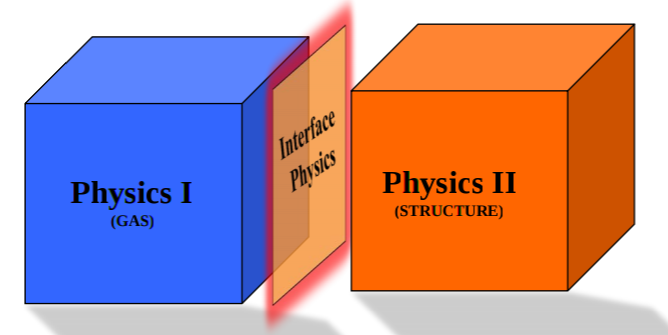
Each domain is simulated numerically by methods observing the respective physics.
The next few images utilize a fluid structure interaction problem in order to adequately demonstration the physical capabilities of Rocstar.
Partitioned and staggered: stepping and interactions are centrally synchronized

Each domain is decomposed into partitions to be distributed among processors.
The domains and shared interface are discretized by each solver application.
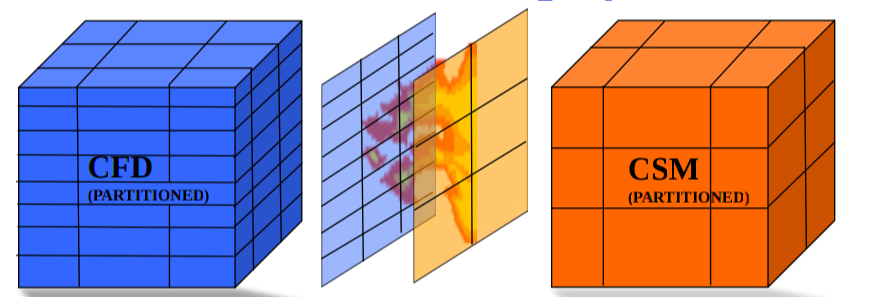
Each computer processor has one or more partitions of one or more solver’s domain.
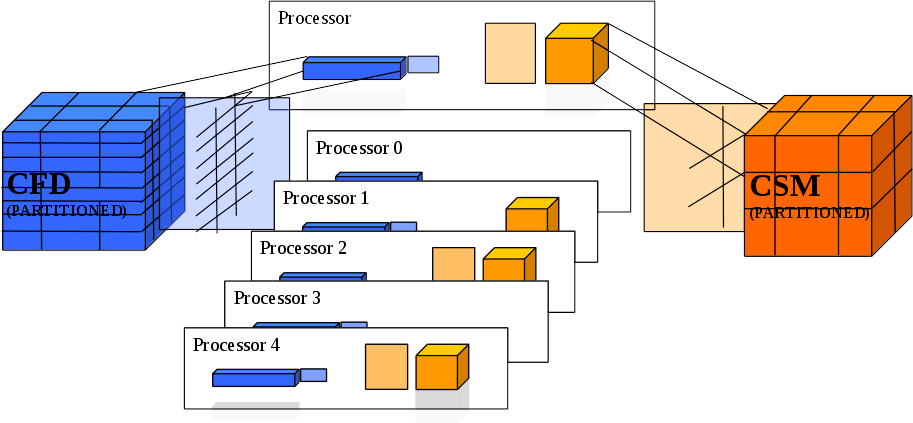
A simulation processor may have an instance of each solver, its domain, and interface. There must be a control flow manager for synchronous stepping, to handle some jump conditions, and unit conversions. To handle the burning, we need a combustion solver capable of operating on geometry and data from other solvers and their domains. We need sophisticated surface propagation capabilities to handle the interface motion due to burning. Mesh modification will be required for handling the extreme changes in geometry due to burning and deformations. Finally, all the pieces have to interact in an efficient manner, sharing data and methods, and working together to simulate the complete system.
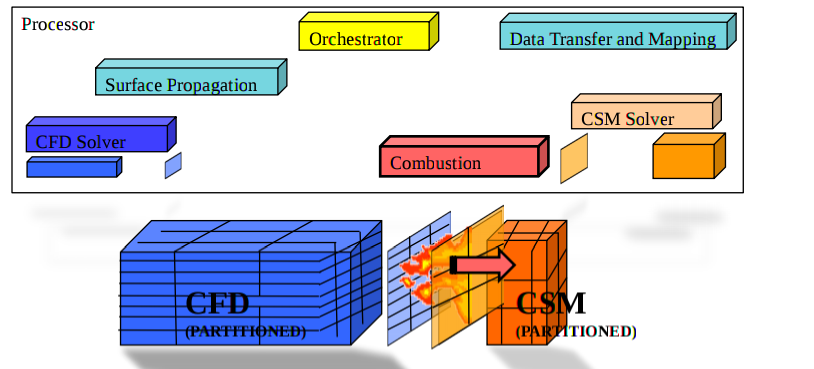
The integration interface provides the mechanisms by which applications can publish and access methods and data. This is the “glue” of the Rocstar multiphysics simulation.
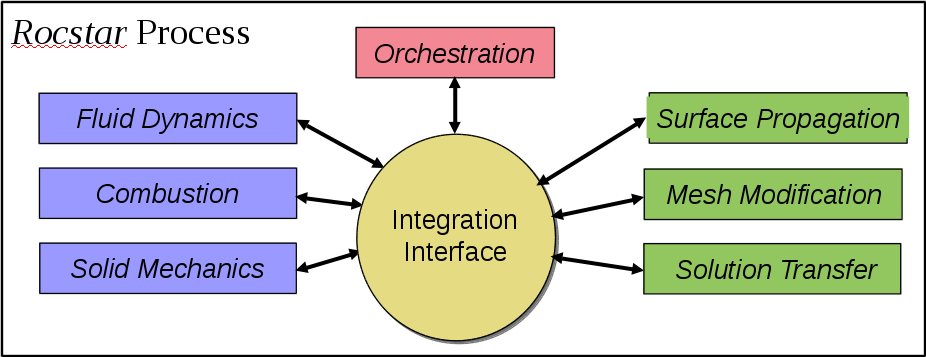
Here is the Rocstar simulation suite architecture layout
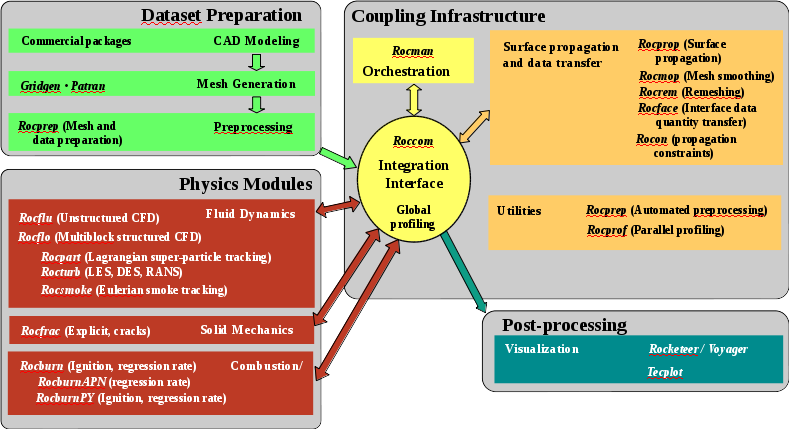
The governing Equations are based off of the unsteady, compressible, Navier-Stokes or Euler equations.
| Fluid Dynamics: Rocflo | Unstructured mesh Fluids: Rocflu |
|---|---|
| 1. Numerical Formulation | 1. Mesh |
| a. Finite volume | a. Mixed tetrahedra, prisms, pyramids, hexahedra |
| b. Explicit Runge-Kutta | |
| c. Arbitrary Lagrangian-Eulerian (ALE) method on moving meshes | 2. Method: |
| d. 2nd order central scheme | a. Explicit, finite-volume, ALE |
| e. Roe upwind scheme | b. First or second order |
| c. Higher order WENO scheme | |
| 2. Code Characteristics | |
| a. Structured, multi-block mesh | 3. Models |
| b. Plug-in modules for turbulence, particles, smoke, radiation | a. Lagrangian particles/super-particles |
| b. Eulerian smoke | |
| c. Built-in propagation constraints | |
| d. Time-zooming |
Both Rocflo and Rocflu require the same files, but have differences in format and naming
ASCII-format Gridgen mesh files produced:
| Rocflo | Rocflu | |
|---|---|---|
| Mesh file | <casename>-PLOT3D.grd | <casename>-COBALT.inp |
| Boundary condition file | <casename>-PLOT3D.inp | <casename>-COBALT.bc |
| Rocflo/Rocflu | |
|---|---|
| Boundary Condition File | <casename>.bc |
| Input File | <casename>.inp |
Gridgen to Rocstar boundary condition map file
| Rocflo | Rocflu |
|---|---|
| <casename>-PLOT3D.bcmp | <casename>.cgi |
| Structural Dynamics: Rocfrac |
|---|
| 1. Large strains, rotations with Explicit/Implicit, ALE |
| 2. Non-linear material models |
| a. Hyperelastic: Arruda-Boyce & Neo-Hookean |
| b. Non-linear constitutive laws: Viscoplastic & Porous viscoelastic |
| 3. Mixed-enhanced elements |
| 4. Transient thermal solver |
| 5. Crack propagation |
| a. Cohesive elements allow failure |
| 6. Stabilized and mixed displacement-pressure elements |
| Required Files | Filename |
|---|---|
| ASCII-format grid file produced by Patran | <casename>.out |
| ASCII-format input file | RocfracControl.txt |
| RocburnAPN | RocburnPY |
|---|---|
| 1. 1-D heat conduction into propellant | 1. 1-D heat equation |
| 2. Uses gas pressure power law | 2. Dynamic heating |
| 3. Provides regression rate for burning propellant | 3. Geometrically dependent film coefficient |
| 4. Burnout capabilities, no heating | 4. Ignition modeling |
| 5. Burnout | |
| 6. Provides aPn regression rate for burning elements | |
| 7. Can use lookup tables |
| Choose only one ASCII-format input file |
|---|
| RocburnAPNControl.txt |
| RocburnPYControl.txt |
These sections are adapted from the Multiphysics and PhysicsModules powerpoints respectively.